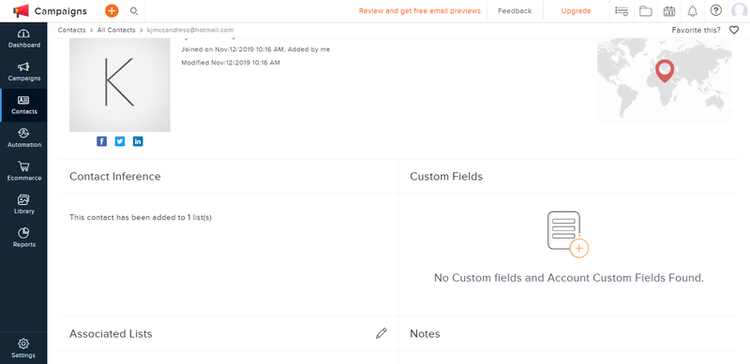Even if your company works like a well-oiled machine, you have an awesome team, and your product is the best thing since bread, it’s not going to be to everyone’s tastes. For example, I hate goat cheese, so even if you have created the healthiest, tastiest range of goat cheese salads, there’s still no way I’d buy them.
But there are people who can’t get enough of goat cheese -- or whatever your product or service niche is -- and you need to know who they are and what they want, so you can better serve them. That’s where your customer profile comes in.
Where do your customers live? How much do they want to spend on goat cheese salads? How often do they buy these salads?
By using this kind of information to create a customer profile you can understand your buyers, create more targeted marketing campaigns, improve customer satisfaction, and develop a better sales strategy.
Overview: What is a customer profile?
A customer profile -- otherwise known as a target market profile -- is a representation of the characteristics of the people who have bought your products or services. This consumer analysis should include information on:
- Customer demographics, such as age and location
- Purchase history
- Interests
- Buying patterns
It differs from a buyer persona in that a customer profile uses factual information that you’ve collected on your customer, while a buyer persona is a fictional representation of your ideal customer.
You can create multiple customer profiles for different types of products. For example, you might create one profile for your sportswear product line and a different one for your fashion line.
Benefits of creating a customer profile for your small business
Businesses that know who their customers are can find more prospects, increase sales, build relationships, and improve loyalty.
1. Inform your product road map
Instagram started off life as Burbn, a Foursquare-style check-in app. But its users loved its photo-sharing capabilities, so it switched focus to give them what they wanted. And the rest is history.

Instagram started life as Burbn before pivoting based on its customer profile. Image source: Author
With a customer profile, you can better understand which features they like best about your product, which lines are most popular, how much they are willing to spend, and how often they want to buy what you’re offering.
For example, if you know that your customers typically have an income of more than $100,000, you can focus on creating higher-end products.
2. Increase customer satisfaction and loyalty
Instead of trying to solve every problem out there, creating a customer profile helps you focus on what matters most to your target customer. They’ll be more satisfied with what you offer if it fully meets their needs and doesn’t make them pay for unnecessary bells and whistles.
Tailoring your offerings to your buyers shows your customers you are listening to them and that you care about what they want. Not only are you more likely to design a product or service that makes them happy, they are also more likely to tell other people just how great you are.
3. Better target your marketing
Using the spray-and-pray method of marketing -- where you try to reach as many people as possible and hope that some part of your message resonates with them -- is much less effective than highly targeted marketing campaigns.
When you have created an effective customer profile, you can spot trends that help you create marketing campaigns that better serve your customers’ preferences and characteristics.
You can use this information to segment your marketing list, and serve each type of customer only the content that is relevant to their interests and history. This means happier customers, and a more engaged audience.
How to create a customer profile for your business
Being able to make sense of your existing data and knowing where to look for additional information is key to the success of your customer profiling efforts. Take the steps below to learn more about your audience and create a customer profile that will get results.
1. Review your buyer personas
Creating a customer profile doesn’t have to mean reinventing the wheel. You’ve already put a lot of hard work into creating marketing and sales documents and identifying leads: Put this information to good use.
Your buyer personas will likely have been based on your mission statement and the problem that your business was set up to solve. You’ve already identified the kind of people who will benefit from what you do, and you know how you can meet their needs, so make sure these ideas underpin your customer profile.
2. Survey your customers
A customer profile focuses on real-world data. The more information you can get from your customers, the better your profiles will be. While in an ideal world you might want to speak to customers face-to-face or on the phone, that’s not always possible.
Surveys help you collect a ton of useful information with minimal effort from the customer.
You can email customers a survey and offer an incentive. Or send them a survey as part of an order confirmation email. You can even have a chat with them in-store if you have a physical location.
Create a few quick questions that will help you get to know them and understand what they are looking for from you.
3. Analyze customer interactions
Your customer profile shouldn’t be based just on the people who have bought your products. It’s also important to look at everyone who has visited your website, as well as people who have subscribed to your email newsletters and anyone who has engaged with you on social media.
Look at the demographic data of people who regularly interact with your business across all touchpoints. Think about:
- Whom they follow on social media
- Their interests
- Where they live
- What products they like or have bought in the past
- What websites they visit
- How they interact with your business
If you’re not sure how to analyze your data, then it’s worth investing in a customer relationship management (CRM) system. This software automatically collects and centralizes your customer data. Choose a solution with robust analytics functionality that allows you to create reports on customer behavior.
Take Zoho Campaigns. Its CRM functionality centralizes all your customer data, meaning you can understand their past behavior and mould a marketing campaign and communication based on this data.

Zoho Campaigns helps you better understand your customers and what they want. Image source: Author
4. Do market research
You’re not the first company to ever have gone through this process; you can glean insight from those who have gone before you, especially other businesses in your industry. Get inspiration from the customer profile examples that are publicly available, and adapt them to your needs.
If you’re not sure what information to include, talk to an industry expert who knows your market and the kind of people who buy your products.
Remember that your customer profile is a living document, and that you need to update it as your business grows and evolves.
Each time you add a new product line or service that targets a different audience or that differs from what you currently offer, you need to create a new customer profile that you can use for prospecting and targeting this new group of people.
Get to know your customers better
If you want to take it one step further and use your customer profile to improve your marketing campaigns and understand how to better target your customers, then consider investing in a marketing automation system.
This will enable you to strategically automate outreach with triggered emails and behavior-based journey builders, as well as launch lasting sales and marketing processes, track performances, and optimize your marketing over time.
Our Small Business Expert
We're firm believers in the Golden Rule, which is why editorial opinions are ours alone and have not been previously reviewed, approved, or endorsed by included advertisers. The Ascent does not cover all offers on the market. Editorial content from The Ascent is separate from The Motley Fool editorial content and is created by a different analyst team.